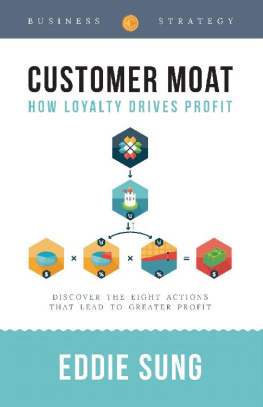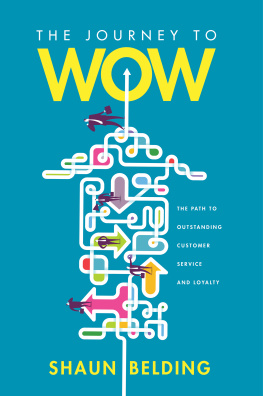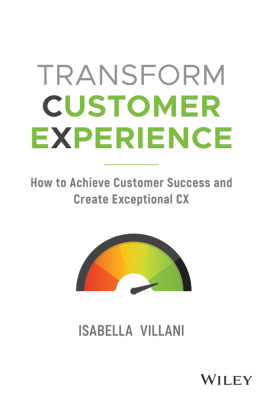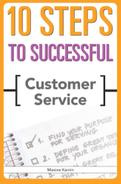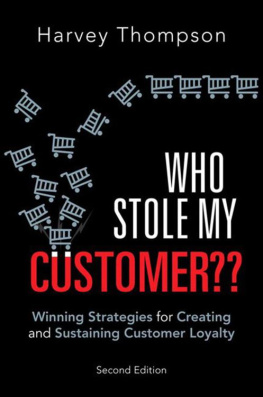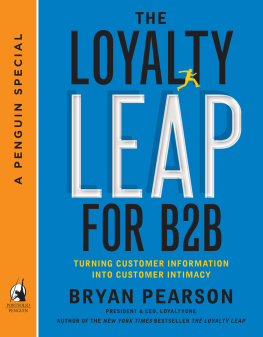Eddie Sung - Customer Moat: How Loyalty Drives Profit
Here you can read online Eddie Sung - Customer Moat: How Loyalty Drives Profit full text of the book (entire story) in english for free. Download pdf and epub, get meaning, cover and reviews about this ebook. genre: Romance novel. Description of the work, (preface) as well as reviews are available. Best literature library LitArk.com created for fans of good reading and offers a wide selection of genres:
Romance novel
Science fiction
Adventure
Detective
Science
History
Home and family
Prose
Art
Politics
Computer
Non-fiction
Religion
Business
Children
Humor
Choose a favorite category and find really read worthwhile books. Enjoy immersion in the world of imagination, feel the emotions of the characters or learn something new for yourself, make an fascinating discovery.
- Book:Customer Moat: How Loyalty Drives Profit
- Author:
- Genre:
- Rating:4 / 5
- Favourites:Add to favourites
- Your mark:
- 80
- 1
- 2
- 3
- 4
- 5
Customer Moat: How Loyalty Drives Profit: summary, description and annotation
We offer to read an annotation, description, summary or preface (depends on what the author of the book "Customer Moat: How Loyalty Drives Profit" wrote himself). If you haven't found the necessary information about the book — write in the comments, we will try to find it.
Customer Moat: How Loyalty Drives Profit — read online for free the complete book (whole text) full work
Below is the text of the book, divided by pages. System saving the place of the last page read, allows you to conveniently read the book "Customer Moat: How Loyalty Drives Profit" online for free, without having to search again every time where you left off. Put a bookmark, and you can go to the page where you finished reading at any time.
Font size:
Interval:
Bookmark:
Customer Moat
Unveiling the Secrets of
Business Strategy
Eddie Sung
Kindle Optimized - Best Read in Portrait Mode

8 Moat Builders
LOW COST (O): The Low Cost moat builder uses a businesss internal operations to reduce the cost of serving customers.
HIGH SATISFACTION (O): The High Satisfaction moat builder uses a businesss internal operations to enhance customer experiences.
ECONOMY OF SCALE (S): The Economy of Scale moat builder leverages the ability of customers to provide a low-cost benefit to other customers.
NETWORK EFFECT (S): The Network Effect moat builder leverages the ability of customers to improve the experiences of other customers.
LOCATION (P): The Location moat builder uses physical positioning to increase the likelihood that customers choose a business.
BRANDING (P): The Branding moat builder uses mental associations to increase the likelihood that customers choose a business.
SUPPLY (I): The Supply moat builder reduces the competitive intensity of an industry by limiting the alternatives available to customers.
DISTRIBUTION (I): The Distribution moat builder reduces competitor access to customers by building pathways that bypass rivals.
O - Operations, S - Scale, P - Positioning, I - Industry Control
Copyright 2016 by Eddie Sung
All Rights Reserved.
No part of this book may be used or reproduced in any manner whatsoever without written permission except in the case of brief quotations embodied in critical articles and reviews.
For information about permissions to reproduce selections of this book, please visit www.cmoat.com.
Books may be purchased in bulk for educational, business, or promotional sales use. Information can be found at www.cmoat.com.
Library of Congress Control Number: 2015917185
Ebook Version 1.2
ISBN-13: 978-0-9969190-1-2
ISBN-10: 0-99-691901-5
Paperback Version
ISBN-13: 978-0-99-69190-0-5
ISBN-10: 0-99-691900-7
*For endnotes and references, please refer to printed editions of the book.
- intro: A JOURNEY BEGINS
- Preface
- PART I: CUSTOMER MOAT FORMULA
- One
- Two
- Three
- Four
- PART II: the EIGHT MOAT BUILDER TOOLS
- Five
- Six
- Seven
- Eight
- Nine
- Ten
- Eleven
- Twelve
- PART III: THE ORIGIN OF PROFITS
- Conclusion
A Journey Begins
Give me a lever long enough and a place to stand, and I will move the world.
archimedes
I t was on a cool Saturday morning in October 2004 that I finished packing the last of my possessions into a rented Ford Windstar van. I was leaving behind a life that I established in Chicago. After finishing my undergraduate degree, I landed a job as an operations consultant. Everything had been going well, but now I suddenly found myself heading far away from the towering skyscrapers of the Windy City.
My destination was Lake Charles, Louisianaa small city that sits at the southwestern heel of the state, near where the warm waters of the Gulf of Mexico butt against the Texas-Louisiana border. This region has long been shrouded in a cloud of industry. Its landscape is dominated by oil refineries and chemical plants, with a river that cuts through that both divides the land and serves as its economic lifeblood. By far the most important attribute of Lake Charles was that it was the place my parents called home.
My parents immigrated to the United States from Taiwan in the 1970s. In their search for opportunity, they discovered a life of hard work and long hours. Even though they encountered numerous setbacks, they believed in the promise of the American dream: those who worked hard would be rewarded.
In 1980, they decided to pursue their ambition by becoming entrepreneurs. They purchased a small grocery store on the northern outskirts of town in a relatively underserved neighborhood. As is often the case with small family businesses, their store quickly took over their lives. My sister and I grew up knowing the store as our perpetually demanding third sibling.
Over the years, I watched as my parents worked tirelessly. The grocery store was open seven days a week, from seven in the morning to nine thirty at night, 365 days a year. On holidays, the entire family pitched in to keep the doors open when most other stores were closed. These were some of our busiest times.
Survival sat first and foremost on my parents minds. Always looming in the background were national giants like Wal-Mart and Kroger. To combat their presence, my parents adopted a strategy of pushing for greater sales through the use of heavy promotions and large discounts. Over the years, this appeared to work, as revenue soared thirtyfold, and at its peak, the store employed twenty-five workers.
Success, however, cannot be measured by size alone. My parents achieved substantial sales growth, but they accomplished little in the way of financial success. Profits remained elusive, and what seemed a prosperous, thriving business was a growing internal disaster. In a vicious cycle, the more the store grew, the more capital investment it took: purchasing coolers, fixing freezers, repairing roofs, repaving parking lots. The business was a bottomless money pit. With each passing year, my parents had to run faster just to stay in place.
In 2002, after two decades of struggle, they threw in the towel and sold the store. They realized that their situation was unsustainable. Luckily, a bright spot remained that allowed my parents to hold onto their entrepreneurial dreams. Over the years, a small side business inside the grocery store had been growing and prosperinga booth dedicated to cashing checks and paying utility bills. Upon selling the grocery business, my parents opened a small storefront across the street, dedicated to those limited financial offerings.
As my parents embarked on this new venture, they were not wealthier people, but their years of hard work had paid off in less tangible ways. My sister and I had the fortunate opportunity to attend the University of Chicago. Thanks to my parents strong encouragement, college was not a place for teaching me a specific skill set but a fleeting time and space where I could learn anything that my heart desired. It was a rare gift for which I am still grateful.
I majored in public policy, but my curriculum was largely liberal arts based. My curiosity drove me to explore all facets of the world. From behavioral economics to probability to immunology, any subject that piqued my interest was fair game. My deep underlying fascination was in discovering the nature of systemswhether they happen to be economic, mathematical, or biological.
Out of all subjects, I was most drawn to business. While my college did not offer a degree in the field, I devoted innumerous hours devouring everything I could find on the subject matter: its strategies, theories, and practices. The forces and behaviors that drove and doomed companies captivated me. In front of me was an incredibly complex game that was not only poorly understood but held such vast implications for the health of our society.
Font size:
Interval:
Bookmark:
Similar books «Customer Moat: How Loyalty Drives Profit»
Look at similar books to Customer Moat: How Loyalty Drives Profit. We have selected literature similar in name and meaning in the hope of providing readers with more options to find new, interesting, not yet read works.
Discussion, reviews of the book Customer Moat: How Loyalty Drives Profit and just readers' own opinions. Leave your comments, write what you think about the work, its meaning or the main characters. Specify what exactly you liked and what you didn't like, and why you think so.

